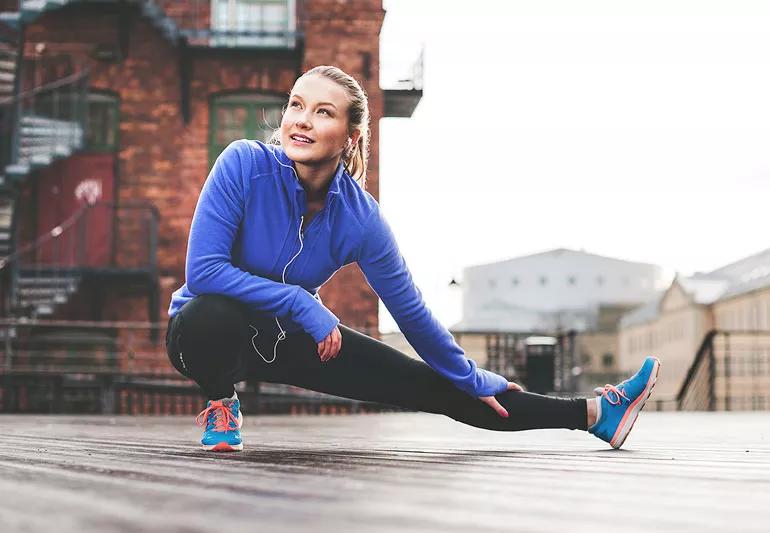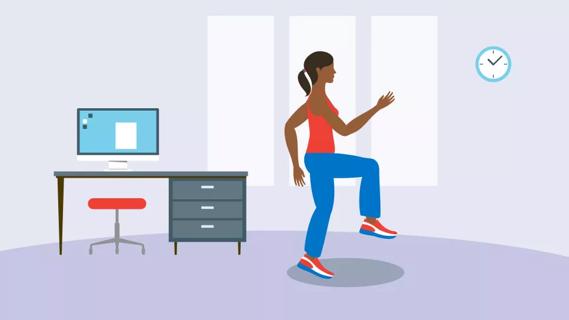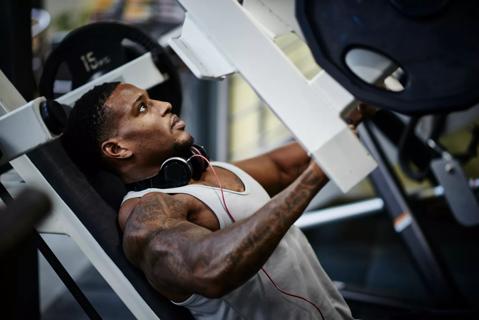Keep active in the cold

It’s easy to get out for a run or other form of outdoor exercise when the sun is shining and it’s nice and warm. But what about during the cold, dark and gray days of winter, when you can feel those brisk, chilled winds deep in your bones?
Cleveland Clinic is a non-profit academic medical center. Advertising on our site helps support our mission. We do not endorse non-Cleveland Clinic products or services. Policy
Whether you’ve been a regular outdoor runner for years or you’ve only recently started up a new exercise routine, the freezing temps and foul weather of winter pushes a lot of people indoors for the season.
But with many gyms closed or exercisers not comfortable going back thanks to the coronavirus (COVID-19) pandemic, where else can you go? With preparation, precautions and planning, it’s definitely possible to keep fit with outdoor workouts until spring returns.
We talked to orthopedic surgeon Michael J. Scarcella, MD, about the best outdoor exercises for wintertime and how to stay safe while training in the ice and snow.
The most important thing when doing, well, anything outside in colder temps is to make sure you’ve dressed appropriately. You’ll want clothes that fit you right for whatever the activity is and you’ll want to make sure that you’re prepared for the cold air.
For more active things events like running, hiking or cross-country skiing, consider layers that can be taken off and added back later, allowing you to more comfortably — and safely — balance rising body temperatures with the cold air temperatures.
“The layer closest to your skin should be a moisture-wicking material, like lightweight polyester or polypropylene, to take moisture away from your skin to the outer layers to evaporate,” says orthopedic surgeon Dominic King, DO.
The second layer is the insulating layer, which should be wool or polyester fleece. The third, outer layer needs to be wind and rain-repellent. When exercising in the cold, King says, this third layer should be removed unless it is raining, snowing or very windy. If worn during exercise, this layer can trap sweat and not allow for proper evaporation. You can always put the top layer back on during rest times outdoors.
There are also specially made caps and winter hats made to help wick away sweat while retaining heat. Likewise, be sure to wear gloves to protect your hands and fingers. If exercising in extreme cold, consider combining gloves and mittens or a liner under your gloves.
Sporting goods stores are good sources of information for the different layers you’ll need for each activity. You can also talk to your healthcare provider about this, too, to make sure you have all the info for cold-weather layering.
Walking and running are the easiest of the outdoor exercises to keep up during the cold winter months as they don’t really require much in the way of extra gear or certain conditions. As long as it’s not too cold, you can pretty much put on your shoes and, with some extra preparation, hit the road.
Just be careful about sidewalk conditions: surfaces can often be uneven which can cause injuries if you’re not paying attention. And do your best to keep to clear sidewalks as snow and ice can make things even more treacherous.
“With any movement-related activity, warm-ups and cool-downs are essential for cold weather activities,” Dr. Scarcella says. “I always recommend a dynamic warm-up, which uses movement to warm your muscles up as opposed to the more traditional static stretching which involved just holding positions.”
The dynamic stretching approach, he says, gives the body an active range of motion to warm muscles up that’s similar to the exercise you’re about to perform. This is definitely a must when running but if you’re just getting ready for a cold, winter walk, it’s not as essential.
As for static stretching, that’s still a good practice for when you’re done with your workout. “It’s always beneficial to hold those stretches for a good period of time, from 30 seconds to about 2 minutes,” Dr. Scarcella notes. “Make sure it’s a tolerable stretch, though, and not causing pain because you want to keep that flexibility and pliability in the muscle after working out.”
With the onset of the COVID-19 pandemic and the closing of gyms, there was a wave of new runners on the streets across the country and that could continue into the winter. Be sure you get the right shoes for running. Having ill-fitting sneakers can derail your running before it really gets started.
“If you’re new to running or not naturally a runner,” says Dr. Scarcella, “it’s best to start with a running program or consider getting enrolled in a program like ‘Run Smart,’ which is run by Cleveland Clinic, that help people with their running, their form and their program.”
Look out for overuse injuries, too, especially if you’re new to running. “Typically, we see knee- and hip-related issues,” says Dr. Scarcella. “And if you’re really ramping it up above what your body’s capable of doing, there’s a risk of stress fractures. If you’re just starting out, this can be a really disappointing setback and you always want to start out in a positive way. So be sure to start a program that fits your level of training.”
Hiking is another exercise that, as long as the weather’s okay and you have the right gear, you can do year-round.
As with running, overuse is always a risk, according to Dr. Scarcella. So don’t hike more than you can handle; start with shorter routes and work your way up. “Moderation is always good,” he says, “so start with easy, flatter climbs,”
It’s also good, then, to have a solid plan in place. “Planning a route is important not just because it’ll help you from getting lost,” Dr. Scarcella adds, “but because it’ll firm up your plans when you’re in the cold and it’ll have you spending as little time exposed to the elements as possible.”
Like running, you’ll want to make sure you take to the trails with the proper footwear but for different reasons. First of all, Dr. Scarcella says, be sure whatever shoes you’re wearing on your hike are waterproof.
“If you’re hiking in winter, there’s a chance you could be hiking through snow and if your shoes aren’t waterproof, that could get your socks wet which has several consequences,” he notes. Besides being at risk for blisters, there’s a good chance of your feet becoming cold and changes in sensation which, he says, increases the risk of taking a bad step or another injury when hiking on an uneven surface.
Like a lot of these activities, cycling is definitely doable in the winter but your ability to pull it off regularly may vary depending on where you live and the corresponding weather. You’ll probably have an easier time of a January ride in Austin, Texas than you would in Cleveland, Ohio.
“Be careful to stick to clear roads, especially if you’re new to cycling,” Dr. Scarcella suggests. “Obviously, it’s easy to be aware of conditions but you want to avoid riding on any roads or paths that aren’t salted or cleared.”
As with running, he says you’ll want to make sure you incorporate dynamic stretching into your warm-up routine so you can get your body warm, especially in cold weather. And be sure, like everything else, to start slow. “You probably want to start off with a pretty straight-forward ride,” he says. “Don’t go right into the hardest portion right off the bat.”
And be sure you’ve got the right gear for your body. That can make all the difference.
While any of these exercises can affect your knees, hips and feet, cycling poses unique challenges in that you’re in a seated position for the duration of the exercise. This can cause issues that new cyclists may not account for when hitting the road, particularly if you have a history of knee or hip pain.
“One trick to keep in mind is to adjust the bike’s seat height since that changes how deep your knees or hips go into flexion,” Dr. Scarcella suggests. “If you have a lot of anterior knee pain (pain in the front of your knees) the saddle is probably too low. Conversely if you have a lot of posterior knee pain (pain in the back of your knees) the saddle maybe too high.”
And if you clip your feet into your bike, consider adjusting the clip locations if you find yourself experiencing knee or ankle pain. “Experiment with what works best for you to offload any joint pain,” Dr. Scarcella advises.
Like the weather, what kind of activities you can enjoy will vary depending on where you live. Here are a few other outdoor exercises that you might consider this winter.
Dynamic stretching is especially important for this exercise, Dr. Scarcells says, particularly in the core muscles. “We tend to see patellafemoral pain, shoulder impingement pain, and low back pain related to overuse or improper form” he points out. Correct form will also be important so you don’t cause yourself any unnecessary injury or strain. Be sure not to collapse your elbows or knees inward.
Like with many of these other exercises, too, it’s important to start small and build up your endurance and duration. Given the risk of exposure, you don’t want to go too hard or far right away and find yourself stuck or struggling to get home.
A popular choice all over the country, ice skating is a regular winter activity that can be done at a wide range of levels, from the laid back fun skates around rinks to more active applications like speed skating or even as part of playing hockey.
If you’re doing it more for aerobic purposes, Dr. Scarcella advises dynamic stretching for your hips and core. He also notes that footwear is important: “Make sure your footwear fits and supports your ankles well.”
Lessons or instructions from an experienced skater aren’t a bad idea for new skaters, either, he says. And it’s important to, again, not try to do too much your first few times out. “The most common injuries we see are ankle sprain or fractures, ACL tears, labral tears of the hip, head injury, wrist injury, and lacerations” Dr. Scarcella says. “The latter 3 are typically related to falls so proper instruction and form are important to prevent these injuries.”
Whatever you decide to do, Dr. Scarcella says it’s most beneficial to mix up different exercises. “If you’re not an avid devotee to any one particular form of exercise,” he says, “mixing in running with cycling or cross-training is generally better for the body. It helps prevent overuse injuries or exacerbating underlying arthritis issues for folks.”
Learn more about our editorial process.

Both are needed for a healthy body

Counteract psoas muscle stiffness and soreness with stretches that lengthen and strengthen

It may be OK, depending on your health, fitness level and type of exercise

Simple exercises like wall angels and pelvic tilts can help keep your body in an optimal position — and help undo years of improper posture habits

Losing belly fat can reduce your risk for chronic health conditions — try focusing on a diet high in lean protein, exercising regularly, reducing stress and getting quality ZZZs

Stretch before heading outside, keep proper form and avoid jerking or twisting to throw snow

A distressed skin barrier can lead to red, itchy and scaly skin

It’s best to exercise before or after your fast, instead of during it

Your metabolism may torch 1,300 to 2,000 calories daily with no activity

A gentle touch in all the right places may help drain your sinuses